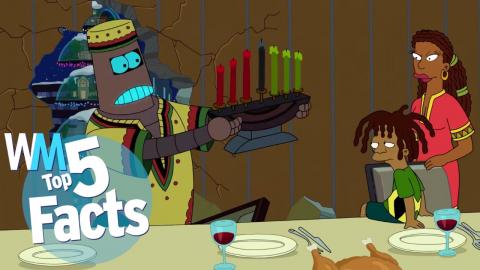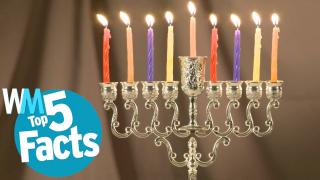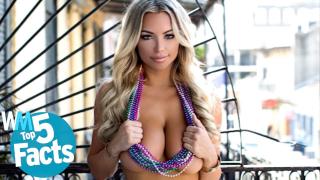Top 5 Essential Kwanzaa Facts

Top 5 Essential Kwanzaa Facts
What is Kwanzaa? If you are among the approximately 25 million people who already celebrate it, you already know: it's awesome. But if you're a total noob, fear not, this episode of Top 5 Facts will bring you up to speed. (In case you're wondering, it's Coolio that voiced Kwanzaa-bot.)
Special thanks to our users EmJay and mac121mr0 for submitting the idea on our Interactive Suggestion Tool at http://www.WatchMojo.comsuggest
Top 5 Kwanzaa Facts
Top 5 Fun & Interesting Facts about Hanukkah
“Happy Holidays” doesn’t just refer to Christmas and Hanukkah. Welcome to WatchMojo’s Top 5 Facts. In today’s instalment, we’re counting down the top five facts about Kwanzaa. This particular holiday isn’t actually a religious one, but a rather a cultural celebration that begins on December 26th and runs until January 1st.
#5: It’s Not An Ancient African Holiday
Top 5 OUTRAGEOUS Mardi Gras Facts
Most people have heard of Kwanzaa, but many haven’t got the faintest clue what it’s actually about. Like many others, including myself, you’ve likely assumed that it’s some ancient African holiday. But… we’ve all got it totally wrong. As of 2016, Kwanzaa is only 50 years old. Surprised? It’s also explicitly an African American holiday, not an African one. Created by Dr. Maulana Karenga, it celebrates community, family, culture and reconnecting with African roots. While it draws inspiration from African harvest celebrations, it is fundamentally an American holiday. A secular celebration unrelated to religion, it really isn’t a substitute for Christmas either. Roughly 18 million African Americans celebrate Kwanzaa, and many of them do it immediately following their Christmas festivities.
#4: The Candles Have A Specific Meaning
Top 5 Weird Facts About Dreams
No… that is not a menorah. But the traditional candleholder of Kwanzaa, known as the “kinara,” is admittedly similar in appearance to the Jewish Hanukkah menorah. The kinara consists of seven candles - three red, one black, and three green. One candle is lit on each of the seven days of Kwanzaa, from left to right. Each candle represents one of the seven principles of Kwanzaa, and the color of the candles also gives them another meaning in addition to the seven principles. The single black candle represents the African American people. The red candles represent the struggle of the people, and the green ones– their hope for the future. This trio of colors, also known as the Pan-African colors, are the colors used to decorate for Kwanzaa as well.
#3: It’s An Inclusive Holiday
Top 5 Facts About iPhones
Kwanzaa might be a holiday specifically created for African Americans, but the founder insists that it is an inclusive Holiday– one in which individuals outside of African American communities should feel welcome to partake. It’s been compared to Cinco de Mayo and Chinese New Year, holidays stemming from and celebrating a specific culture, but which attracts people of all ethnicities. The founder hopes that it can one transcend all racial divides much like St. Patrick’s Day, bringing people together to celebrate African culture in the same way we do with Irish traditions. The Seven Principles of Kwanzaa are important values, from which any person can benefit, and only good can result from more Americans learning about African American and African history and culture. So… Joyous Kwanzaa everyone!
#2: It Ends With A Feast
Top 5 Facts about Airport Security
Kwanzaa is a holiday with a positive focus - it’s all about community and embracing your heritage. Holiday practices involve dancing, storytelling, poetry, drums, community events and a wide variety of other fun-filled traditions. But as we all know, any major holiday, like Christmas, Thanksgiving or Hanukkah, needs a truly epic meal. Well, fear not, because Kwanzaa has got that covered - it ends with a literal feast. On the seventh and final day of Kwanzaa a feast called “karamu” is held. The menu is diverse and can include any number of dishes from African American, African, Caribbean or even South American cuisines. You never know what will be served, but you can be sure there will be plenty of it.
#1: Seven Is The Magic Number
Top 5 Facts about Lipstick You Should Know!
You've probably picked up on it, but the number “seven” comes up a lot when discussing Kwanzaa. There are seven days, seven candles and seven principles. Each one of these days, represented by a candle, takes it’s holiday name from the specific guiding principle of that day. Umoja means unity. Kujichagulia means self-determination. Ujima means working together. Ujamaa means supporting each other. Nia means purpose. Kuumba means creativity. Imani means faith - specifically, faith in oneself. Additionally, there are the seven symbols used in Kwanzaa celebrations: the seven candles, the candleholder, a mat, corn, a unity cup, and gifts. As far Kwanzaa is concerned… good things come in sevens, not threes. How much did you know about Kwanzaa? Are you planning on partaking in any Kwanzaa celebrations this holiday season? For more principled top 10s and not particularly religious Top 5s, be sure to subscribe to WatchMojo.com.







